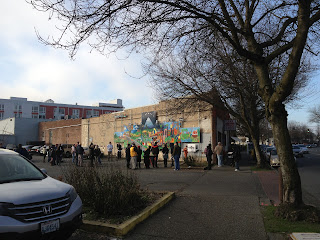Our photo essay examines the way public and private space is
used in the International District and Columbia City. We interpret a ‘Shared
City” as blurring between public and private domains. The first photo shows police descend on a
private Chinese association gathering in the International District. These photos show how this private event is
allowed to shut-down the public street temporarily through permitting. The Chinese association showcases Kung Fu for
elders and visitors. The photo of the Public sidewalk in the International
District shows how public space is occupied by local merchants. They are selling bags of mixed vegetables for
one dollar.
Our next
location was in Columbia City South Seattle. Here a mural unveiling displays how private
space is used publicly. The mural took 18 months to complete and was sponsored by
a variety of public and private community associations. The event attracts a dozen people at first,
but as the crowd grows a larger audience is attracted by the mural. Neighborhood
non-profit groups and community organizations helped to fund this mural
project; they receive a sort of advertising acknowledgement on the mural. The
building and parking lot are privately owned, but they clearly benefit the
public. The mural displays the past,
present and Utopian future of Columbia city.
The mural highlights the cultural diversity of Columbia city. Finally the
photo looking through the window of full tilt ice-cream shows how this
particular business will benefit from the increased foot traffic. The privately owned mural businesses and helps
to brand Columbia city as a cultural diverse tourist destination. We often
think about urban space as either public or private, but this binary does not
explain the reality of urban living. Often public space is used by private
organizations, and increasingly private space is used for the public good.
-Isaiah and Jun
-Isaiah and Jun








